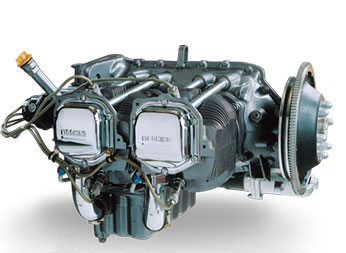Lycoming Nomenclature Made Easy!
July 2015 - Ever wonder where all the letters and numbers for Lycoming engines came from and what they all mean? I recently came across a June 1972 copy of EAAC Canadian Sport Aviation News, where an explanation of the numbers relating to an O-320 Lycoming engine appeared in an article edited from a Falco newsletter by a Mr. Al Constant.

The venerable O-320
It’s all rather confusing, but stay with me.
‘O’ or ‘IO’
All of these engines are basically the same with one exception - the H model. So to start, the first letter, “O,” indicates a carbureted engine. If the letter “I” proceeds this first number, this indicates an injected-fuel system.
320
This represents the basic “cubic-inch” displacement of the engine, but read on.
‘150’ or ‘160’ hp, A, -B, -C, or -D
Here it gets murky. It appears that the heads (or pistons) are machined to produce low-compression (150 hp) or high-compression (160 hp) versions.
Now there are many other variables. For instance, the crankcases are all cast in the same basic mold, but the lugs are machined differently for Type 1 or Type 2 Dynafocal mounts. Almost all carburetors and injectors are mounted in the bottom, and almost all injectors are mounted in the bottom. The exceptions being the carbureted O-320-D made for the Grumman American Cougar with the carburetor mounted on top. Also the Twin Comanche engines (IO-320-A, -B, and -C) also have the injectors mounted on top.
So these letters refer to various combinations of carburetor and injector locations and Type 1 or Type 2 Dynafocal- or conical-mount configurations.
O-320-A1, O-320-B1, and O-320-C1 or O-320-A2, O-301-B2, and O-320-C2
The numbers after the first letter determine whether the crankshaft is hollow (No. 1 for constant speed propellers) or solid (No. 2 for fixed-pitch propellers).
IO-320-A3, IO-320-B3, and IO-320-C3
The initial engines - IO-320-A1, IO-320-B1, and IO-320-C1 - were made for constant-speed propellers with 3/8-inch attachment bolts. These proved to be problematic, so the crank flanges were changed to 7/16-inch. They were named IO-320-A3, IO-320-B3, and IO-320-C3, making the original ones obsolete and are no longer being manufactured.
Finally, the letter following the central number determines the accessories installed. The usual variable is the magnetos: Bendix or Slick.
Sometimes the letter D is added as in O-320-H2AD. This indicates a Bendix dual magneto in a single-case driven by a single-drive.
The exception to all of the above is the “H” series engines, which proved to be problematic. Cessna installed them in some of its Skyhawks, creating a real nightmare for the company. Cessna soon dropped them, and many found their way into the amateur-built category with mixed success.
Learn more about Lycoming and its early history as a sewing machine company here.
Also, did you know that Lycoming made the engine for the Dusenberg J series?
Jack Dueck, Chairman-EAA Canadian Council, EAA 337912
